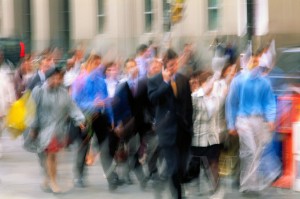What do you “see” when you look at those you come into contact with each day? How do you see the check-out clerk? Your boss? Your secretary? Your wait staff at the local restaurant? The barista who made your coffee? The stranger in line at the post office? The UPS driver?
Do you see people as people? Or do you see them as something else? Alicja Awanska, a Poland anthropologist, did a study of the people living in the northwestern United States. What she discovered was that they tended to divide their world into three categories…
Scenery. This includes things such as nature, weather, politics, and other things in which people have no control.
Machinery. These are “tools” that are used to help people accomplish their work. Machinery is anything used by people “to do the job.” They are possessions.
People. These are human beings who are seen as caring and feeling individuals. They relate well with one another for they are culturally alike.
An interesting discovery in Awanska’s study is that the group she observed did not see everyone as people. They saw “strange people,” such as the American Indians, as scenery. They visited them much like one would visit a zoo. And they saw workers, such as Mexican migrant laborers, as machinery. They were valued only for what they could produce. The only ones viewed as people were family and friends (see chapter 3 in Paul G. Heibert’s book Anthropological Insights for Missionaries for more info on Awanska’s study).
Though Awanska’s study has obvious implications for cross-cultural engagement, I think it also speaks directly to how we tend to see those we encounter in our daily routines. Those we consider scenery are not only individuals who are strange to us, but also those we tend to not notice at all. They are like background music. This is especially true in our world of technology where smart phones continually have our attention.
The ones we see as machinery are usually administrative staff, the wait staff at restaurants, and any other individual that serves us. These are the ones that work for us in one way or another. We ask them, “Can I have more coffee?” “Can you mail this first class?” Can I have fries with this order?”
We must see people as people however. We must see others as ministry instead of scenery and machinery. We must see others as Jesus sees them. The gospel writer Matthew records that Jesus went throughout all the cities and villages, teaching in their synagogues and proclaiming the gospel of the kingdom and healing every disease and every affliction. When he saw the crowds, he had compassion for them, because they were harassed and helpless, like sheep without a shepherd” (Matthew 9:35-36).
Jesus saw people in need and had compassion. When he saw the woman at the well, he saw a woman with unmet desires (John 4). When Jesus met Zacchaeus, he saw a man confused about what would make him happy (Luke 19:1-10). It was they, and us, whom Christ came to serve and to lay down his life (Mark 10:45).
So how do we see those around us? Do we see them as Christ sees them? Do we realize they are the ones for whom Christ came? Do we see them as people created in the image of God? Or do we see them as just scenery and machinery?

[…] We should seek to listen to the stories behind the faces we encounter. We should seek to see people as people. Is this not, after all, what it means to love your neighbor as yourself? (Matthew […]